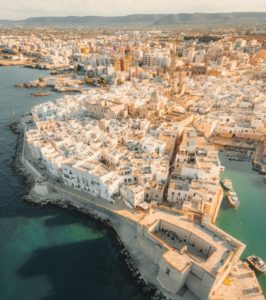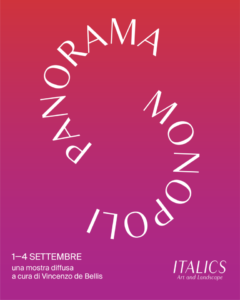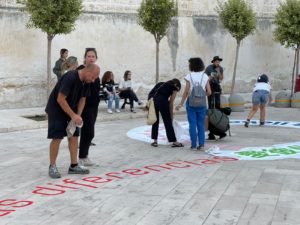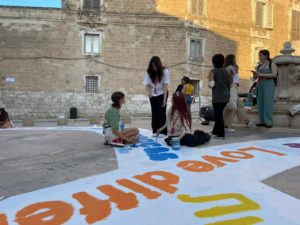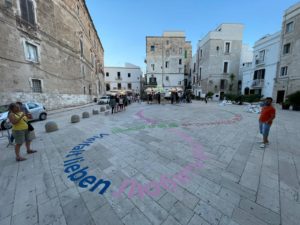Twenty exhibition spaces dotted around palaces, churches, squares, votive aedicules in secluded alleyways, hosting 70 works from the 15th century to the present day, including 7 performances, created by 60 international artists¹ from different eras, generations and nationalities: this is, in a nutshell, Panorama Monopoli, the second edition of the exhibition organised by Vincenzo de Bellis, director of fairs and exhibition platforms at Art Basel and associate director and curator for visual arts at the Walker Art Center in Minneapolis. Behind the scenes is ITALICS, the first Italian consortium bringing together over sixty of the most influential galleries of ancient, modern and contemporary art active throughout the peninsula; the exhibition Panorama is the special event that ITALICS dedicates on a periodic basis to some of the most extraordinary locations in the Italian landscape, launched last year with the first edition held on the island of Procida, proposing a new itinerary between art, architecture, antiquity and the contemporary, all accompanied by a calendar of opportunities for in-depth study, performances and special projects open to the public. Specifically, the widespread exhibition includes works set up along a route composed of twenty exhibition spaces: the main churches in the village, like the Church and former monastery of Saints Joseph and Anne; the nerve centres of the urban fabric like Piazza Palmieri, where a performance will be staged, Piazzetta Santa Maria and Largo Castello; and other more intimate spaces like small squares, courtyards and votive aedicules in the alleyways of the historic centre, which will house site-specific installations. There will also be seven performances that will activate the places chosen for the action, the local community or other works exhibited in the same context. It is an itinerary that develops in tune with the architectural and natural landscape, and invites people to lose themselves in different formal solutions and themes. The contextual installations will encourage multi-voice dialogues between artists of different generations or eras, alternating with monographic presentations dedicated to contemporary artists.
The xenia
Panorama Monopoli, held with the patronage of UNESCO, the Ministry of Culture, and the support of Regione Puglia – Department of Tourism, Economy of Culture and Territorial Enhancement, and the City of Monopoli – Departments of Culture and Tourism, develops as a big choral tale inspired by the Greek concept of xenia, with each work contributing by offering multiple readings on universal themes that have stimulated the creativity of artists and interested human reflections from the 15th century to the present day. “For the Greeks,” reads the exhibition press release, “the term ‘xenia’ summed up the sense of hospitality and the relationship with the stranger, regulated by basic behavioural norms, such as the custom of honouring the guest with a farewell gift as a sign of having appreciated their visit. In a way, xenia is a ritualised form of friendship based on reciprocity. The concept is linked to that of foreigner, from ‘xenos’, and to the history of Monopoli, which is common to that of many other cities on the Adriatic coast, crossroads of exchanges, interests, peoples and trade. Egnatini (from the Messapian centre of nearby Egnatia), Byzantines, Bretons, Arabs, Spaniards, Venetians have contributed in various ways to making the city’s culture a true polychrome mosaic but, as threatening presences, they have also structured it as a mighty fortress on the sea”.
The Third Paradise and the mirror paintings
Among the artistic proposals of the event is the performance The Love Difference Third Paradise, 2022, scheduled for Saturday 3 September at 6.30 pm in Largo Palmieri. “The Third Paradise,” explain the organisers, “is a reconfiguration of the sign of infinity through the insertion of a central circle symbolising openness, a proposal of practices and sustainability for a responsible transformation of society, which Michelangelo Pistoletto combines with the message ‘Love Difference’ in a participatory performance. This movement was born twenty years ago as a relational creative process for the development of a Mediterranean Cultural Parliament and the growth of self-awareness as ‘singularplural’. From the Mediterranean to the ‘mediterraneans’, from Largo Palmieri to Monopoli, to all those places where cultures and multi-culturality live in search of balance, harmony and sustainable prosperity”. The performance for Panorama Monopoli is curated by CIttadellarte and Galleria Continua with the direct involvement of the Departments of Culture and Tourism of the City of Monopoli, the Banda del Giubileo and the Luigi Russo Art School. For the entire duration of Panorama, that is from 1 to 4 September, four mirror paintings will be on display inside the Monastery of Saints Joseph and Anne. The works, all from 2008 (silkscreens on mirror-polished stainless steel measuring 250 x 125 cm) are entitled Prost. No. 2, Prost. No. 3, Prost. No. 4 and Prost. No.6.

